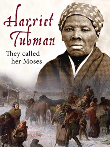This wonderful documentary is relevant today, with its own emphatic statement that “black lives matter.” It’s based on the biography of the diminutive Tubman, remembered today as a leader in the Underground Railroad, one who saved the lives of many slaves and led them to freedom. The documentary focuses on her resilience and her compassion for others. Those traits only grew over her lifetime.
The film is lavishly and sometimes jarringly visual with illustrations, photos, and it features many experts giving interviews about the time period Tubman grew up in, and the hardships she overcame. Narrated by Alfrelynn Roberts, the film is lavishly and sometimes jarringly visual. We see a photo of a slave, his back peppered with wounds from a whipping he received.
It’s noted that the slaves would sing, “Go down Moses, way down in Egypt land, tell old pharaoh, ‘let my people go!’” From this, Moses became Tubman’s nickname because she was a deliverer. Her given name was Araminta Ross, and “Araminta” means “Defender.” How appropriate, as she would later defend her own people and the slaves, as being worthy of freedom. Harriet was born, the fifth child of nine to a slave couple and they lived on the eastern shore of Maryland, the “property” of Anthony Thompson in Dorchester County.
Although the exact date of her birth is not known, it is believed that Tubman was born in either 1820 or 1821. No records were kept because a slave’s birthdate was not considered significant. Carl Westmoreland, an historian from the National Underground Railroad Freedom Center, says, “You buy mules, tractors, you buy things … to pick cotton. Black people were tools.”
He says his mother was sold to prostitution and his father, a very intelligent man, was a bookkeeper. He says that Harriet’s mother was to be set free after the death of her master, but she was never informed of this and remained a slave under the next owner.
The documentary features several horrific stories of the suffering of the slaves, including the fact that Harriet’s two sisters were carried away by a chain gang. Harriet never forgot her sisters’ cries as they were carried off and they were never heard from again. “We were always uneasy,” she said. She was sent away to help a man set muskrat traps on a marshy lake with ice, and she grew sick and was sent back. The man complained that she was “useless! She gets sick too often!” She was only 5 years old at the time.
The documentary spotlights Tubman’s growing faith. She talked to God and her faith grew. Her Christian commitment became more and more obvious as the years passed. She later married a free man named John Tubman, who unfortunately didn’t have the backbone that she did. She always wanted to help other slaves. Dr. Eric Lewis Williams says that, “Christianity was a major force in the lives of the enslaved Africans.” Though some claim Christianity was used to keep slaves in bondage, Lewis adds that it was a source of strength for the slaves. They sang songs about telling Jesus all of their troubles. One of Harriet’s troubles involved a slave who tried to escape and Harriet was told to chase after him. An angry slaveowner wound up throwing a two-pound counter weight in a store at a slave, missed, and hit Harriet in the forehead instead. She carried a scar from the incident for the rest of her life and suffered from seizures and fainting spells.
Many of the slaves began to make their way north, to freedom. Harriet did too. Her husband didn’t want to join her and threatened to report her if she tried. Eventually Harriet did escape and became a member of the Underground Railroad, in which she became a conductor and helped many slaves escape to freedom. When she escaped, two of her brothers went part of the way with her but then turned back. Harriet, her faith in God intact, ventured on. It was said she always told the Lord, “I trust You.” She helped her sister, Mariah, escape to the north. On Jan. 1, 1863, President Abraham Lincoln signed the Emancipation Declaration and soon, following the Civil War, freedom would become a reality for the many that were enslaved. Harriet eventually moved to New York, remarried and adopted a daughter named Gertie. Soon after this, she began to work with Susan B. Anthony for women’s rights. She passed away in 1913 at the approximate age of 90.
We award this inspiring documentary our Dove seal for All Ages, although it is not intended for the very young.
The Dove Take:
This remarkable documentary is so relevant today that it needs to be watched by every family in America!





